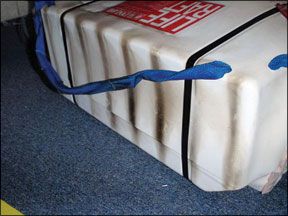I need to buy a marine offshore life raft, and I’ve been considering stowage spots.
I considered a deck-mounted canister. But I’m concerned that my wife would not be able to deploy the raft safely. The

Photos courtesy of Winslow Life Raft Co.
288
canister-packed rafts are typically too heavy for her to lift, and I seriously doubt she’d be able to control one on a wet, heaving deck in heavy weather.
I was all set to store the raft in one of our lazarettes, and then it occurred to me that the raft might be particularly vulnerable to an engine-room fire, because the genset and propulsion engine compartments are located underneath the cockpit sole, inboard of the lazarettes. Both engines are diesel, and I have an automatic fire extinguisher. Nonetheless, the fact that a fire would likely start in one of those engine rooms has me rethinking my idea about stowing the raft in the lazarette. Do you have any information on raft fire resistance?
Jerry Stadulis
Valiant 50
Your safest bet for surviving a fire at sea isn’t a fireproof life raft, it’s being sure to put the fire out as soon as possible. Having an automatic engine room extinguisher, in addition to multiple portable fire extinguishers and smoke alarms are the keys to addressing onboard fires.
That being said, your query got us wondering about any standards for fire-resistance in raft materials. There is no provision in SOLAS (International Convention for the Safety of Life at Sea) regulations regarding life rafts on recreational boats, so we queried a few makers about it.
According to Winslow Life raft Co., there are no flame-resistance requirements for recreational rafts or those certified by SOLAS, the U.S. Coast Guard, or the International Organization for Standards (ISO). As a result, Winslow builds rafts to meet the standards of the commercial aviation industry.
Winslow President Gerard Pickhardt said the company believes flame resistance to be a necessary life-saving feature of rafts. He pointed out that using flame retardant materials can have a significant impact on material cost.
Stephen Jaekel, sales manager for Switlik Life Rafts, echoed Pickhardt’s statement: Switlik “builds to USCG/SOLAS standards and ISO standards. Neither has a flammability requirement.” The company’s SAR-6 Mk-II was one of PS’s recommended products in our April 2007 test of six-man life rafts.
Life raft stowage is a more important issue, in our opinion. Our first pick for stowing a raft would be a dedicated cockpit locker that enables easy access and deployment. We prefer valise-type rafts stowed with a grab bag.
Some European cruisers, like the Nicholson 31, and other boats are designed with built-in life-raft storage. This is ideal but rare. The alternative would be to turn an existing locker into a life-raft locker—as long as the dimensions allow for easy removal of the packed raft and the locker is not used to store anything else. Storing the raft in a locker protects it from theft, vandalism, and boarding waves.
On small boats, especially those with wet cockpit lockers, finding a stowage space belowdecks may be a better option so long as it’s easily accessible and near the companionway. Deck-mounted rafts always face the risk of being washed overboard in heavy weather and should be stored in a hard container, attached to a secure strongpoint by its painter. For obvious reasons, we don’t recommend stowing a life raft belowdecks.
No matter where the raft is stowed, it must be protected from the elements and protected from theft, yet easily deployed in an emergency.
You can check out our last look at life-raft stowage options with this article online or by visiting https://www.practical-sailor.com/tools/life_raft.html.







































